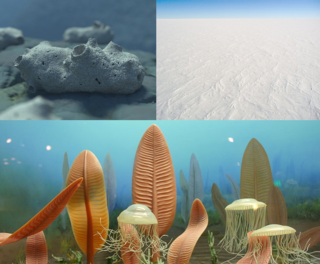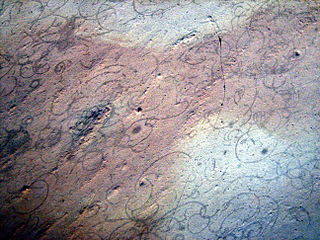
Algae is an informal term for a large and diverse group of photosynthetic, eukaryotic organisms. It is a polyphyletic grouping that includes species from multiple distinct clades. Included organisms range from unicellular microalgae, such as Chlorella, Prototheca and the diatoms, to multicellular forms, such as the giant kelp, a large brown alga which may grow up to 50 metres (160 ft) in length. Most are aquatic and lack many of the distinct cell and tissue types, such as stomata, xylem and phloem that are found in land plants. The largest and most complex marine algae are called seaweeds, while the most complex freshwater forms are the Charophyta, a division of green algae which includes, for example, Spirogyra and stoneworts. Algae that are carried by water are plankton, specifically phytoplankton.

The Ediacaran Period is a geological period of the Neoproterozoic Era that spans 96 million years from the end of the Cryogenian Period at 635 Mya, to the beginning of the Cambrian Period at 538.8 Mya. It is the last period of the Proterozoic Eon as well as the so-called Precambrian "supereon", before the beginning of the subsequent Cambrian Period marks the start of the Phanerozoic Eon, where recognizable fossil evidence of life becomes common.

The Neoproterozoic Era is the unit of geologic time from 1 billion to 538.8 million years ago.

The Doushantuo Formation is a geological formation in western Hubei, eastern Guizhou, southern Shaanxi, central Jiangxi, and other localities in China. It is known for the fossil Lagerstätten in Zigui in Hubei, Xiuning in Anhui, and Weng'an in Guizhou, as one of the oldest beds to contain minutely preserved microfossils, phosphatic fossils that are so characteristic they have given their name to "Doushantuo type preservation". The formation, whose deposits date back to the Early and Middle Ediacaran, is of particular interest because it covers the poorly understood interval of time between the end of the Cryogenian geological period and the more familiar fauna of the Late Ediacaran Avalon explosion, as well as due to its microfossils' potential utility as biostratigraphical markers. Taken as a whole, the Doushantuo Formation ranges from about 635 Ma at its base to about 551 Ma at its top, with the most fossiliferous layer predating by perhaps five Ma the earliest of the 'classical' Ediacaran faunas from Mistaken Point on the Avalon Peninsula of Newfoundland, and recording conditions up to a good forty to fifty million years before the Cambrian explosion at the beginning of the Phanerozoic.

Coralline algae are red algae in the order Corallinales. They are characterized by a thallus that is hard because of calcareous deposits contained within the cell walls. The colors of these algae are most typically pink, or some other shade of red, but some species can be purple, yellow, blue, white, or gray-green. Coralline algae play an important role in the ecology of coral reefs. Sea urchins, parrot fish, and limpets and chitons feed on coralline algae. In the temperate Mediterranean Sea, coralline algae are the main builders of a typical algal reef, the Coralligène ("coralligenous"). Many are typically encrusting and rock-like, found in marine waters all over the world. Only one species lives in freshwater. Unattached specimens may form relatively smooth compact balls to warty or fruticose thalli.
Paramecia is a non-mineralized Ediacaran alga with a differentiated, compartmentalized thallus. This alga probably had multiple phases in its lifecycle, as possible reproductive structures have been identified.

Grypania is an early, tube-shaped fossil from the Proterozoic eon. The organism, with a size over one centimeter and consistent form, could have been a giant bacterium, a bacterial colony, or a eukaryotic alga. The oldest probable Grypania fossils date to about 2100 million years ago and the youngest extended into the Ediacaran period. This implies that the time range of this taxon extended for 1200 million years.

Eoandromeda is an Ediacaran organism consisting of eight radial spiral arms, and known from two taphonomic modes: the standard Ediacara type preservation in Australia, and as carbonaceous compressions from the Doushantuo formation of China, where it is abundant.
The Rhodogorgonales are an order of red algae, a sister group to the corallines. They are always thalloid and calcified; their calcification is very different from the corallines, as individual calcite crystals are deposited in the cell wall of specialised cells; this suggests that the evolution of calcification may have been independent from the corallines. They have no fossil record.
Archaeolithophyllum is a genus of conceptacle-bearing red alga that falls in the coralline stem group. It somewhat resembles Lithophyllum.
Arenigiphyllum is a genus of alga from the Ordovician that falls in the coralline stem group. Only its vegetative anatomy is known.
Petrophyton is a genus of alga that falls in the coralline stem group.
Thallophycoides is an undifferentiated, globular, non-mineralized alga from the Ediacaran period.
Wengania is a non-differentaited, non-mineralized algal thallus under a millimeter in diameter.
Thallophyca is a non-mineralized Ediacarian alga that probably dwelt on the sea floor. Its thallus is differentiated into a cortex and a medulla. Possible reproductive structures have been identified.
Miaohephyton is a carbonaceous compression fossil of a thalloid organism that has been interpreted as a brown alga. Its Neoproterozoic age is incompatible with molecular clocks that estimate the divergence of the brown algae around 300 million years ago, leading to suggestions that its "brown algal" features are the result of convergence.
Anhuiphyton lineatum is an extinct species of Neoproterozoic algae, known from several fossils from the Lantian formation of China, first described in 1994. It lived probably more than 580 million years ago. The thalli were of spherical to elliptical shape, made of thousands of flexible septated filaments. The whole organism was a few centimeters in size. Along with Flabellophyton, it is one of the few septated algae found in the assemblage.

The Dengying Formation is an upper Ediacaran fossiliferous geologic formation found in South China. It was deposited on a shallow marine carbonate platform.
Events from the year 1998 in South Korea.
Shuhai Xiao is a Chinese-American paleontologist and professor of geobiology at Virginia Tech, Blacksburg, Virginia, U.S.A.







